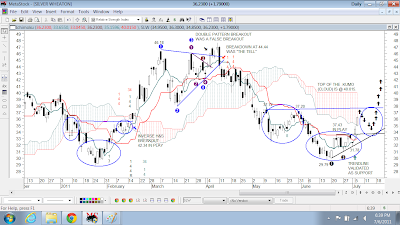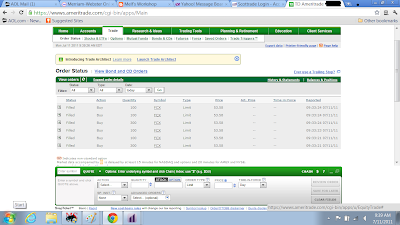
Review of The Bearish Wolfe Wave possibility, from yesterday morning:
"Look back at that Bearish Wolfe Wave, where we got "The Tell" on April 11, at 56.64 and again at 56.33, that all was not well with FCX. In the current time-frame, we've got a strong directional Lead-In off the late June Triple Breakout, just as we had in the early spring, and we've got a similar Bearish Rising Wedge possibility.
Bearish Wolfe Waves usually have a Wave 5 "Fakeout/Breakout." Back in April, FCX had TWO "Fakeout Breakouts." Yesterday's rally fell shy of the putative top trendline by about five cents, so it wasn't a "Fakeout Breakout," but it came close.
A break of trendline #2-#4 would warrant some caution, as would a break of the 54.77 release of earnings low."
We can't say that we weren't prepared for yesterday's action!
My apologies for the chart looking like someone threw a pizza at it, but I ran out of space on it and needed to make room for the Lead-In of the Bearish Wolfe Wave. If you notice, the current pattern looks very similar to the Bearish Wolfe Wave back in the early spring:
1. Both have a strong directional "Lead-In" to the pattern (both were big up moves), which is required of a Wolfe Wave.
2. Both had patterns (Rising Wedges) that were in the SAME direction as the Lead-In, which also is required of a Wolfe Wave. Both the Lead-In and the pattern that followed it (the Rising Wedge) were UP.
3. The Wave 5 "Fakeout/Breakout" that puts the proverbial "everyone" wrong-footed was a Double "Fakeout/Breakout" in the spring. In the current time-frame, we didn't get the "Fakeout/Breakout," which normally is seen in these patterns. We got a simple failure at, and validation of, resistance at the top of the Rising Wedge at the Wave 5 high, on Tuesday (red arrow).
The Target Line, once the pattern broke down crossing 55.2622, is derived by connecting the high of Wave #1 with the low at Wave #4, then continuing that trendline on down. It came in yesterday at 54.23. The session low was 54.26, so I consider that target MADE, it was so close. That doesn't mean that FCX can't go lower. It just means that if I were short the stock, which I tried to be on the rally to 55.62-55.64, I'd "take profits, or at least 'some' profits when targets get MADE."

Since we didn't have the typical Wave 5 "Fakeout/Breakout" in this Wolfe Wave, I took a chance that the lower trendline (55.2622) of the Rising Wedge would be support on the morning selloff, and got long the stock right there. When it dropped to 54.90, which was a significant breakdown, I threw it in on the next rally for a ver-ry small gain and looked to get short if FCX rallied in the Bear Flag (pattern in white) to the horizontal resistance at 55.64, which also was the top of the inverted exponential moving averages, the 34EMA, which was at 55.62.
So, there were at least THREE solid reasons to short there:
1. 55.64 horizontal resistance - that was support at the open. Once broken, "former support 'should be' resistance."
2. 55.62 top of the inverted EMA resistance
3. The Bear Flag pattern, which after the severe drop (which is the "flag pole" for the flag), "should be" a bearish continuation pattern. This is a short-term chart (5-Minute) and the short-term trend was down. Expect patterns to resolve in the direction of the trend in the time-frame at which we are looking.
I placed my order to short 2,500 shares at 55.60, just below that resistance, but I didn't get filled. Apparently, a lot of other folks had the same idea that I did because the high at the top of the Bear Flag only was 55.57, so the stock didn't quite get there. That's fine. Sometimes we don't get the entry that we want, but I wanted to point out that "body of evidence" because it generally is a real nice place to short when we see it.

In this particular case, when FCX broke the bottom of the Bear Flag AND took out the 54.90 morning low AND took out the 54.77 release of earnincgs low that we discussed yesterday morning, it was marked for a fast trip to the Bearish Wolfe Wave target line, at 54.23 (#6 on the daily chart). That's a hallmark of a Wolfe Wave. Usually a sharp move in direction OPPOSITE Wave 5, where the proverbial "everyone" is caught wrong-footed, expecting higher prices. Nice trade for anyone who shorted it.
Notice the interplay of price with the 13...21...34 Inverted EMAs. In Tuesday's session when the EMAs were "in gear," they acted as support. Yesterday, they were resistance. When FCX rallied off the opening low of 55.64, it got smacked after three 5-Minute bars, right where the EMAs were "bunched," after having rolled over to the downside. At the top of the Bear Flag, the stock failed right below the 34 EMA, at 55.57. For the remainder of the session, the best that FCX could manage was weak rallies to the 21 and 13 EMAs, then finally, a failure at the 34EMA near the gong.
The Bulls need to suck down LOTS of spinach in the locker room this morining, before coming out onto the field. LOL.

Gain: lunch money ;)
I'm going to take a break from posting for awhile. Between my cursor jumping around and driving me crazy while I'm trying to type this stuff out, and my strained old eyes killing me while I'm trying to see this little print, I need a rest. LOL.
In the interim, practice...practice...practice. I hope that I've shown you that the market isn't just some "random walk." I didn't see anything "random" about the DOUBLE breakdown in the daily chart yesterday, at 55.2622 and at 54.77, the DOUBLE resistance at 55.62-55.64, or FCX getting to within three cents of the 54.23 Bearish Wolfe Wave target. It certainly isn't easy, but if we collect our "body of evidence" and try our best to FOLLOW what Ms. Market is doing, we'll do alright ;)
Best of luck to all of you with your trading! I'm outta here for awhile ;)
















































